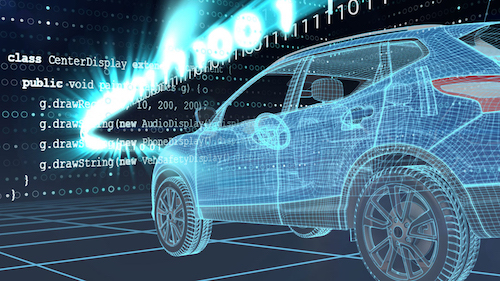Siemens Targets Automotive Players With Integrated PLM and ALM

Siemens’ new automotive solution offers seamless integration between the Polarian ALM and Teamcenter PLM platforms. Image Courtesy of Siemens PLM Software
Latest News
July 19, 2017
High-performance engines, sleek exterior designs and state-of-the-art vehicle components are just a fraction of modern-day automotive design. Today’s vehicles include more than 100 million lines of code and counting, which requires changes to traditional design platforms and processes used to manage development throughout the vehicle lifecycle.
In a nod to the software-heavy content of today’s cars, Siemens PLM Software is introducing the Integrated Software Engineering solution for the automotive industry—a platform specifically tuned to address the development challenges associated with the explosive growth of embedded software in increasingly sophisticated vehicles. The platform melds the Polarian application lifecycle management (ALM) software, acquired by Siemens in November 2015, with the Teamcenter product lifecycle management (PLM) platform. The goal: To help automotive industry players seamlessly manage what officials say are the inherently different lifecycles of electro-mechanical systems and the software created to control those physical systems.
 Siemens’ new automotive solution offers seamless integration between the Polarian ALM and Teamcenter PLM platforms. Image Courtesy of Siemens PLM Software.
Siemens’ new automotive solution offers seamless integration between the Polarian ALM and Teamcenter PLM platforms. Image Courtesy of Siemens PLM Software.As cars become more sophisticated with features like collision avoidance, automatic parallel parking, and the beginnings of autonomous operation, the amount of embedded software content as part of the overall vehicle design is already exploding, experts say. “Software is greatly expanding and 100 million lines of code will grow rapidly as we get into the world of autonomous vehicles,” explains Dave Lauzun, vice president of Automotive & Transportation, Siemens PLM Software. In addition to its critical role creating differentiation through new content and features, software is also the biggest source of automotive recalls, prompting vehicle makers to look for better ways to manage software as part of the broader product development effort.
Historically, managing embedded software development in concert with the more traditional electro-mechanical aspects of a vehicle has been a challenge for a variety of reasons. For one thing, product engineering and software engineering adhere to different development schedules—vehicle makers typically operate in three- to five-year development cycles while software development is much more iterative, adhering to agile development practices, Lauzun says. As a result, software development is typically managed in a separate system, and interface validation with hardware components only happens at pre-defined checkpoints.
However, traditional handoffs and siloed workflows won’t cut it in the era of smart, connected vehicles. Here, software and physical systems demand far more interaction, including the creation of a digital twin of vehicle systems that represents both physical and digital behavior.
The new Siemens Integrated Software Engineering solution tightly integrates the two worlds, creating linkages in areas like requirements management and change management for better traceability. “The change management process loops in and out of the hardware and software world on the way to execution,” explains Lauzun. “This system creates tight linkages between all the various phases so you get it right at the end.”
Watch this video to hear Siemens talk more about the synergies between ALM and PLM platforms.
Subscribe to our FREE magazine, FREE email newsletters or both!
Latest News
About the Author
Beth Stackpole is a contributing editor to Digital Engineering. Send e-mail about this article to [email protected].
Follow DE





